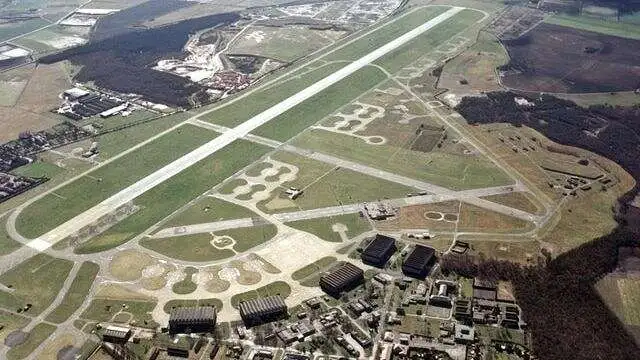
During the refurbishment of the Royal Flying Corps station at Doncaster in 1915, a decision was taken to move operations temporarily to an airstrip at Bancroft Farm at Finningley.
This flight of aircraft is thought to have consisted of Royal Aircraft Factory BE.2c fighters. These fighters were used to intercept Zeppelin bombers approaching Yorkshire cities from the East Coast, in this instance, the heavily industrialised City of Sheffield.
Finningley became a Royal Flying Corps Military Airfield in 1915.
Finningley’s participation in RAF Bomber Command’s offensive may have been short but the station played a vital part in finishing crews with operational training for the bombing role. An early pre-war expansion scheme airfield, the site, farmland in a well-wooded locality four miles southeast of Doncaster, was acquired in the summer of 1935.
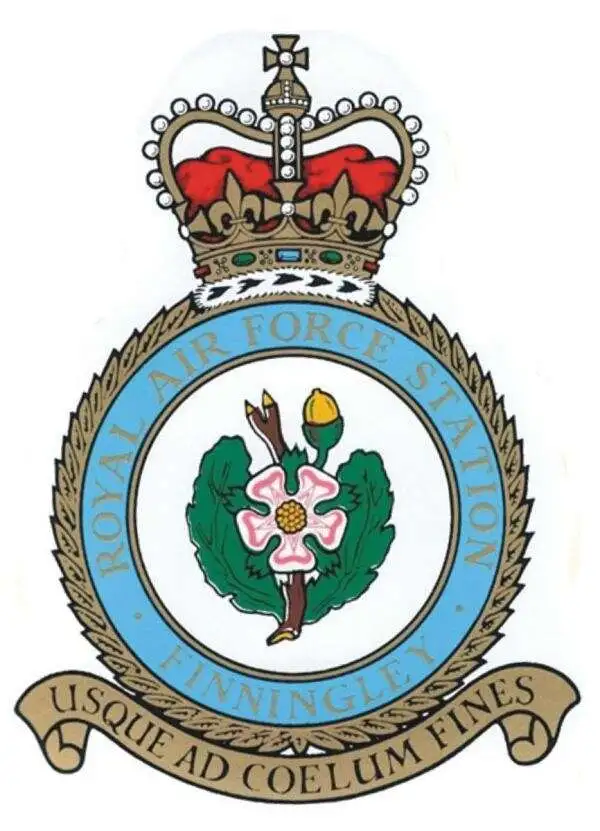
Extending as far as the sky
The Doncaster-Lincoln railway line ran a quarter mile to the north and Finningley village lay a similar distance to the east. The flying field covered around 250 acres (100 ha) with the camp area situated to the northwest between Mare Flats Plantation and the A1 ‘Great North Road’ (now the A638). Four Type C hangars were erected in the usual crescent layout facing the bombing circle, with a fifth directly behind the southernmost of the line. Administration and technical site buildings were immediately to the rear of the hangars.

Handley Page Hampdens in formation, with right; an Avro Anson.
Nos. 7 and 102 RAF Squadrons moved in during August 1936 from RAF Worthy Down with Handley Page Heyfords, this was before the official opening date given in station records (3 September). During the next year, No. 7 Squadron split into No. 76 and No. 102 similarly divided to produce No. 77 the latter two soon being moved south to RAF Honington. No. 7 Squadron converted to Whitleys in March and April 1938 while No. 76 continued to operate Wellesleys, the type it had been formed to fly. By the end of that year No. 5 Group completed its acquisition of No. 3 Group stations north of the Wash and, under its control, Finningley squadrons started the conversion to the Handley Page Hampden, with Avro Ansons to fill out strength until more of this new type were available from production.
The need to establish units devoted to training crews on the new bomber types resulted in the setting up of so-called pool squadrons during the summer of 1939. A revision of this arrangement brought the designated pool squadrons into operational training units and, shortly after war was declared, both the Finningley squadrons moved to Upper Heyford.
Finningley was to continue in a training role for No. 106 Squadron, which brought its Hampdens from RAF Cottesmore in October. Also classed as a reserve squadron, No. 106 continued the operational training role for No. 5 Group that the previous occupants had started to provide.
During early 1940, Fairey Battles of 98 Squadron were moved to RAF Finningley from RAF Scampton.
By August 1940 the critical war situation caused No. 106 to be placed on operational call. Most of its early sorties were to drop mines in the approaches to French Channel ports thought to be harbouring invasion barges. There was still need for a final polish for new Hampden crews and in February 1941 No. 106 left its ‘C’ Flight at Finningley to continue with this task while the rest of the squadron moved to RAF Coningsby for full offensive operations. While flying from Finningley, six Hampdens had failed to return. In March the former No. 106 “C” Flight metamorphosed into No. 25 OTU, initially continuing to train with Hampdens and Ansons. A few Manchesters arrived in the spring of 1941, and the unit was later bolstered with Wellingtons.

Handley Page Wellingtons and Avro Manchesters flew from RAF Finningley.
Early in 1942 Finningley passed to No. 1 Group and with no further need for Hampdens or Manchesters No. 25 OTU concentrated on Wellingtons, nine of which were lost when the station was called upon to take part in Bomber Command operations. No. 25 OTU was disbanded in February 1943 and in March No. 18 OTU moved in from RAF Bramcote and began using RAF Bircotes and RAF Worksop as satellites. In November the Wellingtons were moved to these satellites as hard runways were to be laid at Finningley. These were put down during the winter of 1943–44, the main 03-21 being 2,000 yards (1,830 m), 07-25 4,200 feet (1,280 m) and 12–30 4,200 ft. A concrete perimeter track had been laid and asphalt pan-type hard standings constructed in 1940–41 linked to it.
From 1946 to 1954 a number of different training units were stationed at Finningley with a variety of aircraft types. No. 616 Squadron RAF was re-formed at Finningley on 31 July 1946 equipped with de Havilland Mosquito NF XXX night fighters which were replaced with Gloster Meteor F.3 day fighters a few months later.
A number of units withdrew in 1954 (including No. 215 ATS) leaving only the Meteors of No. 616 Squadron, Royal Auxiliary Air Force, manned largely by part-time personnel, but their days at Finningley were numbered for in May 1955 the squadron moved to RAF Worksop. The reason was that Finningley was about to be given a new lease of life as a V-bomber station.
During the next two years work was carried out to re-lay and extend the main runway to approximately 3,000 yards (2.7 km). Unit stores for atomic weapons were also constructed to house Green Grass in Yellow Sun, Violet Club and Blue Steel weapons. The airfield became known as the home of the ‘V’ Bomber after Avro Vulcans, Handley Page Victors and Vickers Valiants had all been stationed at the base. Finningley maintained its nuclear weapon storage facility for many years.
Finningley re-opened in the spring of 1957, No. 101 Squadron was re-formed in October that year to operate Vulcan bombers. A year later No. 18 Squadron RAF with ECM Vickers Valiants was also established at Finningley. In 1961, No. 101 Squadron RAF took its Vulcans to RAF Waddington changing places with the Vulcan training organisation, No. 230 Operational Conversion Unit RAF. It was then that Vulcan XH558 became housed at RAF Finningley after her initial arrival at RAF Waddington. The Vulcan OCU stayed with RAF Finningley from June 1961 until December 1969.
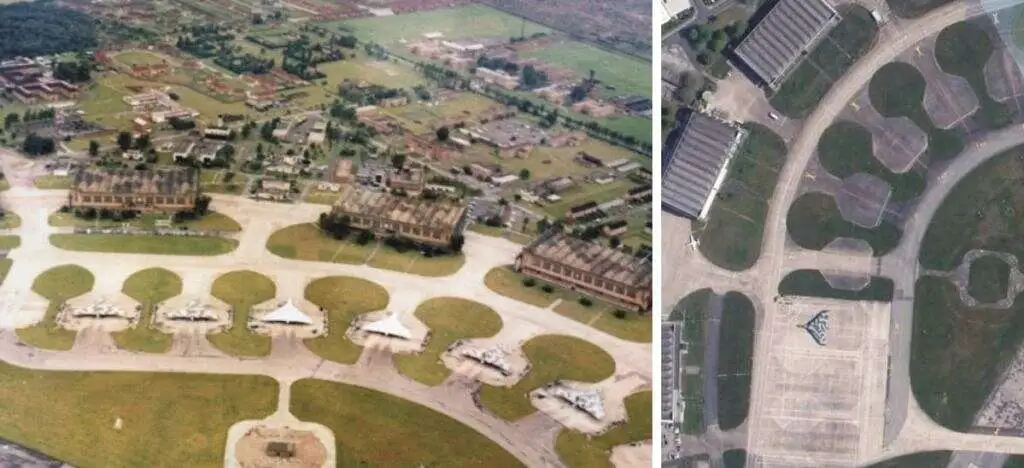
Vulcans on their stands at RAF Finningley during the height of the Cold War, while right: XH558 parked outside Hangar 3 during her later flying life.
Victor Bombers arrived at Finningley in later years before RAF Strike Command (the amalgamation of Bomber and Fighter Commands on 30 April 1968) moved its units out and Training Command took over the station in May 1970.
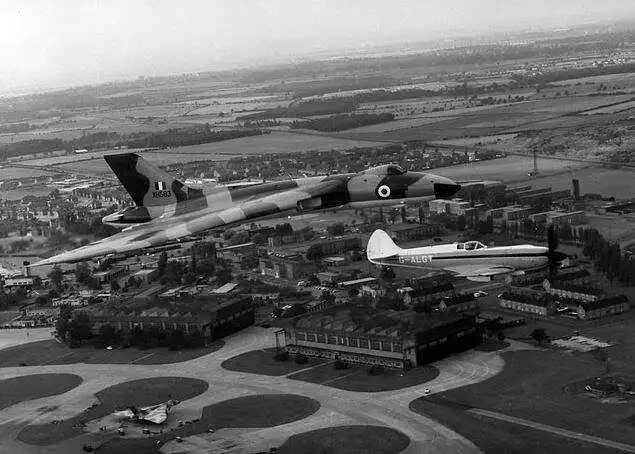
A rare image of a Vulcan and Spitfire overhead RAF Finningley
By now, as you will have read above in our opening article, the V-Force no longer carried Britain’s nuclear deterrent and their role changed to that of low-level bombing, with XH558 herself finding herself later tasked with maritime reconnaissance duties and eventually, as an air-to-air refuelling tanker before the Vulcan squadrons disbanded after their only period of active conflict during the Falklands Conflict of 1982.
Vulcan XH558 would remain as the sole remaining Vulcan on the RAF inventory right the way through to 1993, as the lone display aircraft in the Vulcan Display Flight. At this point, XH558 was once again based at RAF Waddington.
During the 1970s all RAF navigators passed through the Air Navigation School (ANS) of No. 6 Flying Training School (FTS) at RAF Finningley, when the BAe Dominie T.1 s of No. 1 Stradishall and the Varsities No. 2 ANS moved there from RAF Gaydon. During 1970, a Varsity aircraft caught fire in one of Hangars and subsequently destroyed 2 other aircraft by setting them ablaze. Low-level navigation training took place on the BAC Jet Provost, eventually using the T.5A variant.
The Vickers Varsity was phased out in 1976 making No. 6 FTS an all-jet school.

A Handley Page Jetstream and a Hawker Siddeley 125 Dominie – aircraft also based at RAF Finningley.
RAF Finningley also played host to Multi-engine training and Operational Navigation training again via 6 FTS was responsible for training all the Royal Airforce Multi-Engine pilots using twin-turboprop Handley Page Jetstream T.1 aircraft. Later the Jet Provost T.5A aircraft were replaced by British Aerospace Hawk T.1 aircraft and finally, these were replaced by Short Tucano T1.
RAF Finningley was also home to all initial airman aircrew training (Air Electronics Operators, Air Engineers and Air Loadmasters). Finningley was also home to Yorkshire Universities Air Squadron, who flew Bulldogs at the time, as well as Chipmunk T.10s of 9 AEF
In its last years as an RAF station, Finningley was home to No. 100 Squadron RAF who had moved from RAF Wyton. The Squadron’s main tasks were as a target facilities flight providing airborne targets for surface-based radar and missile sites, and as an agile and small ‘aggressor’ aircraft for Dissimilar air combat training (DACT) for UK-based operational aircraft.
The RAF Search and Rescue Wing was first formed at RAF Finningley in 1976, when two squadrons, No. 22 Squadron RAF and No. 202 Squadron RAF, came together from Thorney Island and Leconfield. Finningley became the administrative home of the two squadrons with their bright yellow painted Westland Whirlwind HAR.10, Westland Sea King HAR.3 and Westland Wessex HAR.2 helicopters. All major engineering work was carried out by the Engineering Squadron in Hangar 1.

Westland Whirlwind and Westland Sea King Search & Rescue helicopters.
The first air display at Finningley was held in September 1945. For two decades RAF Finningley was home to the Battle of Britain Air Display which was the largest one-day airshow event in the country, and a similar show was held in Scotland at RAF Leuchars in Fife on the same day as that at Finningley each year.
The aerobatic airshow and the display of military hardware became so well known nationally that the show attracted huge crowds and eventually became televised on national TV. Famous memorable incidents during the airshows include a BAC Lightning breaking the sound barrier above the crowd during a display and an Avro Vulcan bomber scramble.
In 1977, the Queen’s Silver Jubilee Air Show was held at RAF Finningley, replacing for that year, the Battle of Britain Air Show.
In 1994 the Ministry of Defence announced the imminent closure of RAF Finningley as part of the Front Line First defence cuts. It finally closed in 1996.
Following the end of scheduled services from Sheffield City Airport, the former RAF Finningley was reopened as Robin Hood Airport Doncaster Sheffield (DSA) in April 2005, after low-cost flights and rising passenger demand made a new commercial airport feasible. It was then renamed once again to Doncaster Sheffield Airport in 2016.
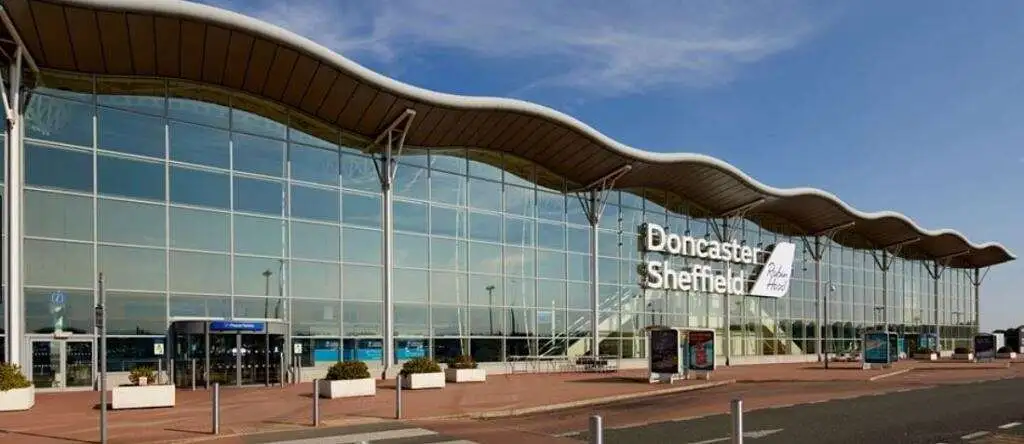
In March 2023, Doncaster Sheffield Airport was purchased by the City of Doncaster Council.